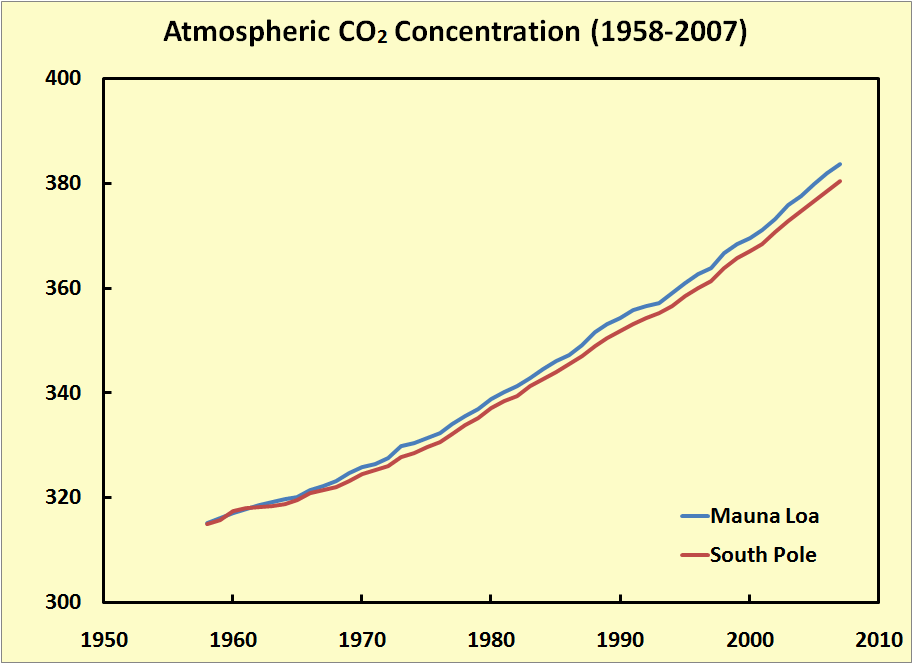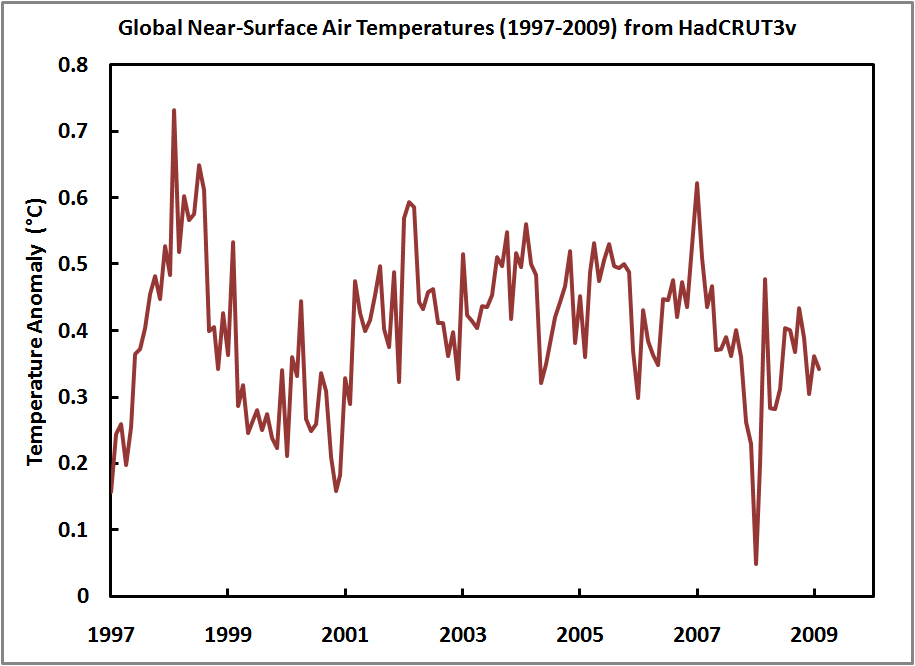Volume 12, Number 14: 8 April 2009
To watch a video presentation of this editorial, click here.
At a recent meeting of climate alarmists in Copenhagen, Denmark, one of the event's co-chairs -- Katherine Richardson -- stated that "the worst-case IPCC projections, or even worse, are being realized." According to the report of the meeting published in Science, she said that "emissions are soaring, projections of sea level rise are higher than expected, and climate impacts around the world are appearing with increasing frequency." These are powerful headline-grabbing contentions. But are they correct?
Consider Richardson's claim that emissions are soaring. Presumably, the emissions to which she refers are those of various greenhouse gases, the most significant of which, after water vapor, is carbon dioxide. If she is correct, one would expect atmospheric CO2 concentrations to be soaring as well. In viewing measurements made at Mauna Loa, Hawaii, and the South Pole, however, there is no sign of a recent radical departure from trends of the past. In fact, there is not even a hint of a tiny departure.

But what about methane, which is the next most powerful greenhouse gas after CO2? As may be seen from this figure, its concentration has actually been rising ever more slowly with the passage of time, to where it now appears to have almost reached a plateau.

With respect to Richardson's second claim, that projections of sea level rise are higher than expected, we are forced to agree with her. Why? Because current climate-alarmist projections of sea level rise are "higher than expected." But being only projections, they may well turn out to be far different from what will actually occur.
As for her claim that climate impacts around the world are appearing with increasing frequency, we can only say that if one studies the steady stream of scientific literature pertaining to this subject -- as we have been doing on a weekly basis for over a decade now -- one will see that she is just plain wrong on this point. And one can verify this fact by perusing the many materials we have archived on our website under the heading of Weather Extremes in our Subject Index.
A British Parliament Member articulated another theme of the Copenhagen meeting, stating that climate negotiators are currently devising regulatory plans based on "data that's out of date." Several of the assembled scientists, for example, criticized the 2007 IPCC report as being too conservative in its ice-loss estimates, because of not including what at the time were new calculations of glacier movements. However, the authors of an even newer study (Nick et al., 2009) conclude that recent high rates of mass loss by Greenland's glaciers "are transient and should not be extrapolated into the future."
Yet another conference attendee claimed that accelerating movements of glaciers in both Greenland and Antarctica would "lead to sea level rise of one meter or more by 2100." Again, however, the most recent studies of Antarctica (Naish et al., 2009; Pollard and DeConto, 2009) clearly demonstrate (Huybrects, 2009) that "the amount of nearby ocean warming required to generate enough sub-ice-shelf melting to initiate a significant retreat of the West Antarctic ice sheet ... may well take several centuries to develop," and that the transition time for a total collapse of the West Antarctic ice sheet may range from "one thousand to several thousand years," which "is nowhere near the century timescales for West Antarctic ice-sheet decay based on simple marine ice-sheet models."
Another scare story came from a scientist who said the last IPCC report underestimated the vast amount of carbon contained in the world's permafrost, which could be released to the air by rising temperatures. However, a detailed study of this phenomenon (Delisle, 2007) indicates that "permafrost will mostly prevail in this century in areas north of 70°N," even for an unbelievable warming of 8°C, and that "permafrost will survive at depth in most areas between 60° to 70°N." This scenario is also supported by the small amount of organic carbon released from permafrost during previous periods of warming, such as the Medieval Warm Period and Holocene Climatic Optimum, when no significant methane excursions were detected in ice core records of either Antarctica or Greenland.
We would also add, in this regard, that studies of melting permafrost sites indicate that with the ability of the thawed lands to host vascular plants, their carbon balances actually become positive; and these observations have led the researchers (Turetsky et al., 2007) to say that permafrost degradation within peatlands "could serve as a negative feedback to net radiative forcing via enhanced carbon accumulation."
Interestingly, the same individual who promoted the peatland scare-story also said that scientists have been unable to find evidence for forests increasing their ability to absorb and sequester carbon as the planet warms and the air's CO2 content rises. In a recent issue of Science, however, Oliver Phillips of the UK's University of Leeds and 65 co-authors demonstrate that over the past quarter-century the productivity of the Amazon rainforest has been significantly "increasing with time," as has been found to be the case with numerous forests the world over (Phillips et al., 2008).
In closing, we present a 12-year history of the parameter that is said to be responsible for the many catastrophes predicted by climate-alarmists. In viewing this graph, does it look like the worst-case projections of the IPCC are being realized? Does it look like there has been even a modest acceleration of warming over the past ten years? In fact, does it look like the earth has warmed at all over the last decade?

The obvious answer to all of these questions is No! The earth has not warmed over the past decade, much less gotten hotter at an ever-accelerating rate. Clearly, the world's climate alarmists are totally out of touch with reality when they claim impending doom, as are their prescriptions for CO2 emissions reductions. We must let everyone know that the "climate crisis" they predict for the planet has absolutely no basis in real-world fact.
Sherwood, Keith and Craig Idso
Reference
Delisle, G. 2007. Near-surface permafrost degradation: How severe during the 21st century? Geophysical Research Letters 34: 10.1029/2007GL029323.
Huybrechts, P. 2009. West-side story of Antarctic ice. Nature 458: 295-296.
Naish, T., Powell, R., Levy, R., Wilson, G., Scherer, R., Talarico, F., Krissek, L., Niessen, F., Pompilio, M., Wilson, T., Carter, L., DeConto, R., Huybers, P., McKay, R., Pollard, D., Ross, J., Winter, D., Barrett, P., Browne, G., Cody, R., Cowan, E., Crampton, J., Dunbar, G., Dunbar, N., Florindo, F., Gebbherdt, C., Graham, I., Hannah, M., Hansaraj, D., Harwood, D., Helling, D., Henrys, S., Hinnov, L., Kuhn, G., Kyle, P., Laufer, A., Maffioli, P., Magens, D., Mandernack, K., McIntosh, W., Millan, C., Morin, R., Ohneiser, C., Paulsen, T., Persico, D., Raine, I., Reed, J., Riesselman, C., Sagnotti, L., Schmitt, D., Sjunneskog, C., Strong, P., Taviani, M., Vogel, S., Wilch, T. and Williams, T. 2009. Obliquity-paced Pliocene West Antarctic ice sheet oscillations. Nature 458: 322-328.
Nick, F.M., Vieli, A., Howat, I.M. and Joughin, I. 2009. Large-scale changes in Greenland outlet glacier dynamics triggered at the terminus. Nature Geoscience 2: 10.1038/NGEO394.
Phillips, O.L., Aragao, L.E.O.C., Lewis, S.L., Fisher, J.B., Lloyd, J., Lopez-Gonzalez, G., Malhi, Y., Monteagudo, A., Peacock, J., Quesada, C.A., van der Heijden G., Almeida, S., Amaral, I., Arroyo, L., Aymard, G., Baker, T.R., Banki, O., Blanc, L., Bonal, D., Brando, P., Chave, J., de Oliveira, A.C.A., Cardozo, N.D., Czimczik, C.I., Feldpausch, T.R., Freitas, M.A., Gloor, E., Higuchi, N., Jimenez, E., Lloyd, G., Meir, P., Mendoza, C., Morel, A., Neill, D.A., Nepstad, D., Patino, S., Penuela, M.C., Prieto, A., Ramirez, F., Schwarz, M., Silva, J., Silveira, M., Thomas, A.S., ter Steege, H., Stropp, J., Vasquez, R., Zelazowski, P., Davila, E.A., Andelman, S., Andrade, A., Chao, K.-J., Erwin, T., Di Fiore, A., Honorio C., E., Keeling, H., Killeen, T.J., Laurance, W.F., Cruz, A.P., Pitman, N.C.A., Vargas, P.N., Ramirez-Angulo, H., Rudas, A., Salamao, R., Silva, N., Terborgh, J. and Torres-Lezama, A. 2009. Drought sensitivity of the Amazon rainforest. Science 323: 1344-1347.
Phillips, N.G., Buckley, T.N. and Tissue, D.T. 2008. Capacity of old trees to respond to environmental change. Journal of Integrative Plant Biology 50: 1355-1364.
Pollard, D. and DeConto, R.M. 2009. Modelling West Antarctic ice sheet growth and collapse through the past five million years. Nature 458: 329-332.
Turetsky, M.R., Wieder, R.K., Vitt, D.H., Evans, R.J. and Scott, K.D. 2007. The disappearance of relict permafrost in boreal North America: Effects on peatland carbon storage and fluxes. Global Change Biology 13: 1922-1934.




